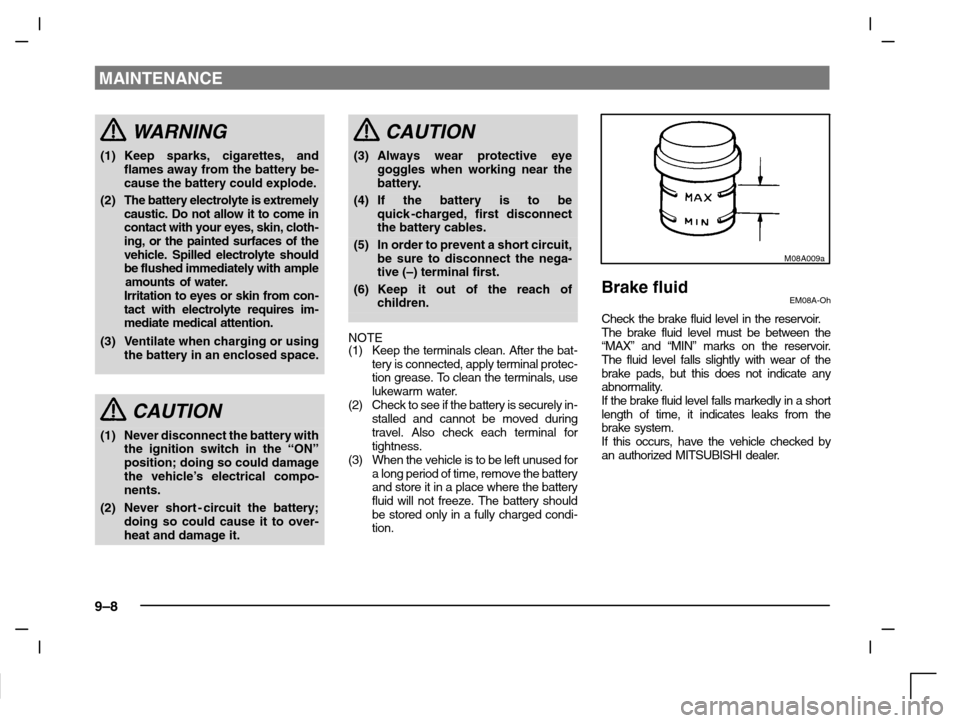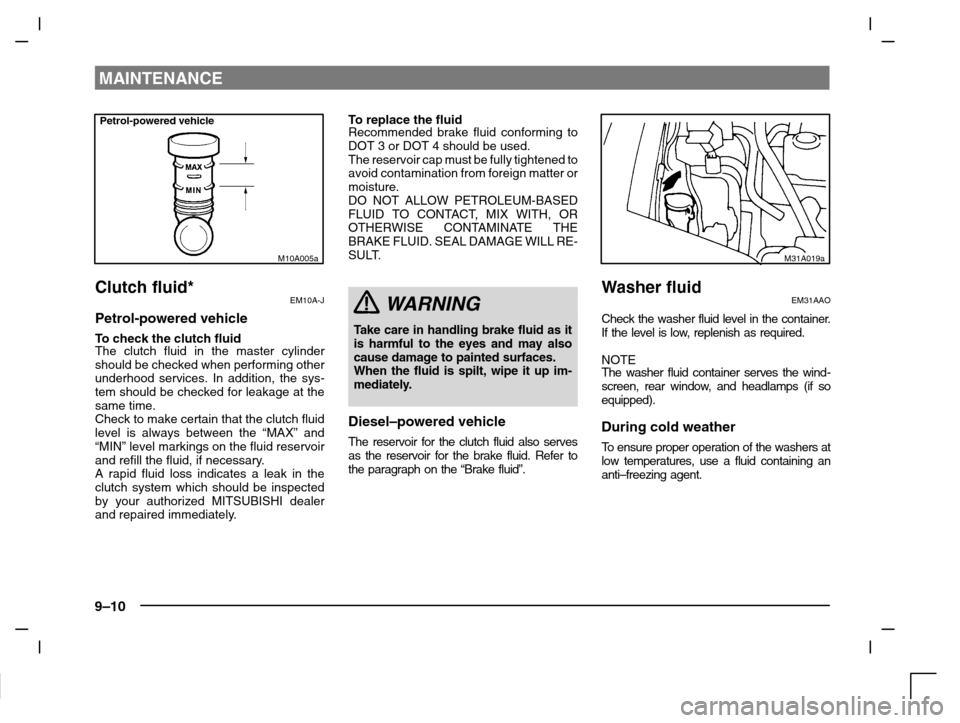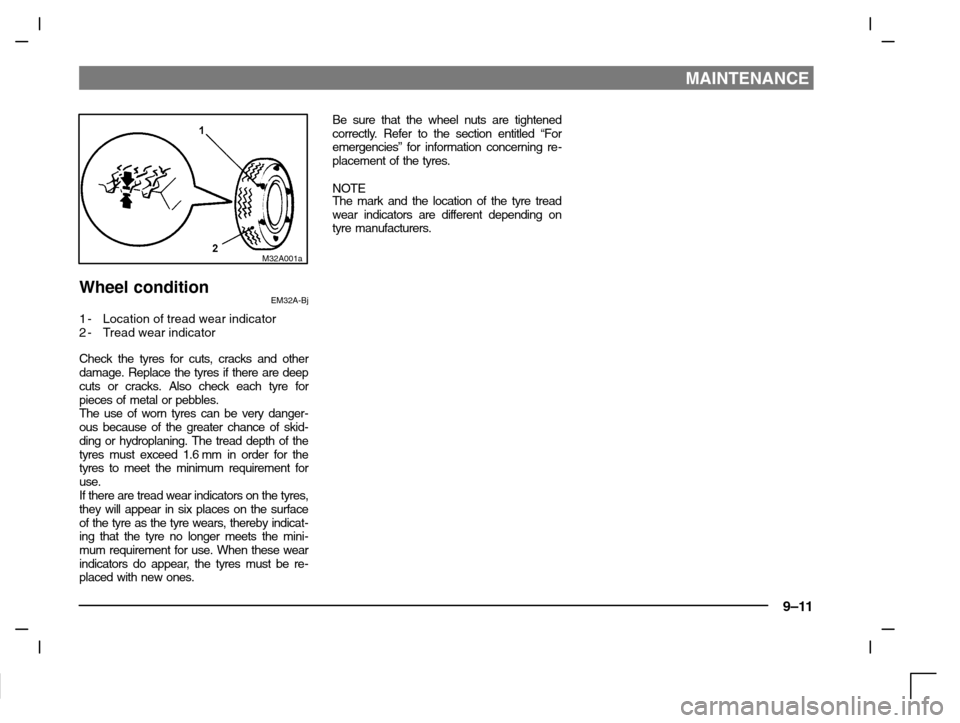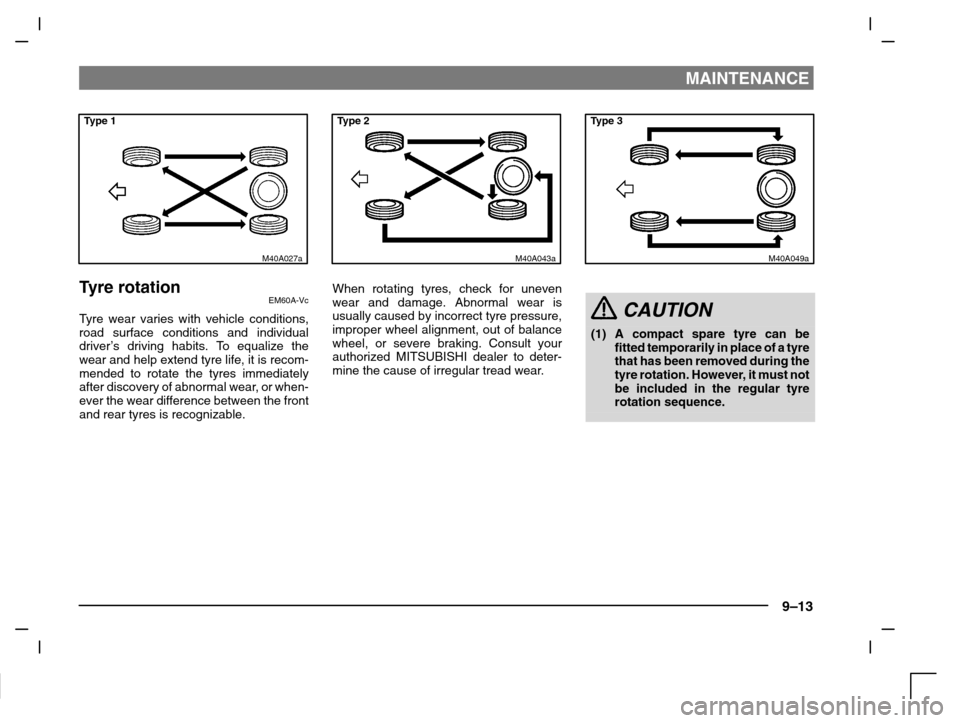2000 MITSUBISHI CARISMA maintenance
[x] Cancel search: maintenancePage 244 of 280

MAINTENANCE
9–6
Anti–freeze
The engine coolant contains an ethylene
glycol anti–corrosion agent. The cylinder
head and water pump housing are cast alu-
minium alloy, and periodic changing of the
engine coolant is necessary to prevent cor-
rosion of these parts.
Use High–quality Ethylene–glycol includes
coolant.
It has excellent protection against corrosion
and rust formation of all metals including alu-
minium and can avoid clogs in the radiator,
heater, cylinder head, engine block, etc.
Because of the necessity of this anti–cor-
rosion agent, the coolant must not be re-
placed with plain water even in summer. The
required concentration of anti–freeze differs
depending on the expected ambient tem-
perature.CAUTION
(1) Do not use alcohol or methanol
anti–freeze or any engine cool-
ants mixed with alcohol or meth-
anol anti–freeze. The use of an
improper anti–freeze can cause
the corrosion of the aluminium
components.
(2) For effective anti–corrosion and
anti–freeze performance, keep
the anti–freeze concentration
within the range of 45 to 60%.
Concentrations exceeding 60%
will result in a reduction of both
the anti–freeze and cooling per-
formance thus adversely affec-
ting the engine.
(3) Do not top off with water only.
Water by itself reduces the rust–
protective and anti–freeze qua-
lities of the coolant and has a
lower boiling point. It can also
cause damage to the cooling sys-
tem if it should freeze. Do not use
tapwater, or it could cause cor-
rosion and rust formation.
During cold weatherIf the temperatures in your area drop below
freezing, there is the danger that the coolant
in the engine or radiator could freeze and
cause severe damage to the engine and/or
radiator. Add a sufficient amount of anti–
freeze to the coolant to prevent it from freez-
ing.
The engine coolant mixture used at the fac-
tory provides protection against freezing for
temperatures as low as approximately
–30°C. The concentration should be
checked before the start of cold weather and
anti–freeze added to the system if necess-
ary.
Page 245 of 280

MAINTENANCE
9–7
BatteryEM37A–Pd
The condition of the battery is very important
for quick starting of the engine and proper
functioning of the vehicle’s electrical system.
Regular inspection and care are especially
important in cold weather.
NOTE
(1) After replacing the battery, the electronic
control system data for the engine, auto-
matic transmission, etc., will be erased.
As a result, the engine speed may be-
come unstable and shift shocks may
occur.
If the engine speed become unstable,
initial engine adjustments will need to be
performed.
Refer to the section “What to do if the
engine speed becomes unstable after
the battery is replaced:” on page 8–22.
Shift shocks will become smoother after
several changes in speed.
(2) Memory data for settings made by the
user may be erased when the battery is
replaced. If this happens, establish the
settings again using the relevant pro-
cedures.
M37B003a
Checking battery electrolyte level
The electrolyte level must be between the
“max” and “min” marks stamped on the out-
side of the battery. Replenish with distilled
water as necessary.
The inside of the battery is divided into sev-
eral compartments; remove the cap from
each compartment and fill to the “max” mark.
Do not over -replenish beyond the “max”
mark because spillage during driving could
cause damage.
Check the electrolyte level at least once
every four weeks, depending on the operat-
ing conditions.
If the battery is not used, it will discharge by
itself with time. Check it once every four
weeks and charge with low current as
necessary.
During cold weather
The capacity of the battery is reduced at low
temperatures. This is an inevitable result of
its chemical and physical properties. This is
why a very cold battery, particularly one that
is not fully charged, will only deliver a fraction
of the starter current which is normally avail-
able.
It is recommended that you have the battery
checked by an authorized MITSUBISHI
dealer before the start of cold weather and,
if necessary, have it charged.
This not only ensures reliable starting, but a
battery which is kept fully charged also has
a longer life.
Disconnection and connection
To disconnect the battery cable, stop the en-
gine, first disconnect the negative (–) ter-
minal and then the positive (+) terminal.
When connecting the battery, first connect
the positive (+) terminal and then the nega-
tive (–) terminal.
Page 246 of 280

MAINTENANCE
9–8
WARNING
(1) Keep sparks, cigarettes, and
flames away from the battery be-
cause the battery could explode.
(2) The battery electrolyte is extremely
caustic. Do not allow it to come in
contact with your eyes, skin, cloth-
ing, or the painted surfaces of the
vehicle. Spilled electrolyte should
be flushed immediately with ample
amounts of water.
Irritation to eyes or skin from con-
tact with electrolyte requires im-
mediate medical attention.
(3) Ventilate when charging or using
the battery in an enclosed space.
CAUTION
(1) Never disconnect the battery with
the ignition switch in the “ON”
position; doing so could damage
the vehicle’s electrical compo-
nents.
(2) Never short - circuit the battery;
doing so could cause it to over-
heat and damage it.
CAUTION
(3) Always wear protective eye
goggles when working near the
battery.
(4) If the battery is to be
quick -charged, first disconnect
the battery cables.
(5) In order to prevent a short circuit,
be sure to disconnect the nega-
tive (–) terminal first.
(6) Keep it out of the reach of
children.
NOTE
(1) Keep the terminals clean. After the bat-
tery is connected, apply terminal protec-
tion grease. To clean the terminals, use
lukewarm water.
(2) Check to see if the battery is securely in-
stalled and cannot be moved during
travel. Also check each terminal for
tightness.
(3) When the vehicle is to be left unused for
a long period of time, remove the battery
and store it in a place where the battery
fluid will not freeze. The battery should
be stored only in a fully charged condi-
tion.
M08A009a
Brake fluidEM08A-Oh
Check the brake fluid level in the reservoir.
The brake fluid level must be between the
“MAX” and “MIN” marks on the reservoir.
The fluid level falls slightly with wear of the
brake pads, but this does not indicate any
abnormality.
If the brake fluid level falls markedly in a short
length of time, it indicates leaks from the
brake system.
If this occurs, have the vehicle checked by
an authorized MITSUBISHI dealer.
Page 247 of 280

MAINTENANCE
9–9
Use brake fluid conforming to DOT3 or
DOT4. The brake fluid is hygroscopic. Too
much moisture in the brake fluid will adverse-
ly affect the brake system, reducing the
brake performance.
In addition, the brake fluid reservoir is
equipped with a special cap to prevent the
entrance of air, and this cap should not be re-
moved.
The brake fluid level is monitored by a float.
When the brake fluid level falls below the
“MIN” mark, the brake fluid warning lamp
lights up.
WARNING
(1) Take care in handling brake fluid as
it is harmful to the eyes and may
also cause damage to painted sur-
faces. If fluid is spilt, wipe it up as
soon as possible.
(2) Use only the specified brake fluid.
Also, the additives in different
brands may result in a chemical re-
action when mixed together, so
avoid mixing different brands if
possible.
(3)Normally, keep the reservoir tank
cap closed to prevent the brake
fluid from deteriorating.
Petrol-powered vehicles
M09A029a
Power steering fluidEM09A-Oa
Check the fluid level in the reservoir while the
engine is idling.
Unscrew the reservoir cap; the level in this
tank should be kept between the “MAX” and
“MIN” lines.
Use “ATF DEXRON II”.
Diesel-powered vehicles
M09A030a
Page 248 of 280

MAINTENANCE
9–10
Petrol-powered vehicle
M10A005a
Clutch fluid*EM10A-J
Petrol-powered vehicle
To check the clutch fluidThe clutch fluid in the master cylinder
should be checked when performing other
underhood services. In addition, the sys-
tem should be checked for leakage at the
same time.
Check to make certain that the clutch fluid
level is always between the “MAX” and
“MIN” level markings on the fluid reservoir
and refill the fluid, if necessary.
A rapid fluid loss indicates a leak in the
clutch system which should be inspected
by your authorized MITSUBISHI dealer
and repaired immediately.
To replace the fluidRecommended brake fluid conforming to
DOT 3 or DOT 4 should be used.
The reservoir cap must be fully tightened to
avoid contamination from foreign matter or
moisture.
DO NOT ALLOW PETROLEUM-BASED
FLUID TO CONTACT, MIX WITH, OR
OTHERWISE CONTAMINATE THE
BRAKE FLUID. SEAL DAMAGE WILL RE-
SULT.
WARNING
Take care in handling brake fluid as it
is harmful to the eyes and may also
cause damage to painted surfaces.
When the fluid is spilt, wipe it up im-
mediately.
Diesel–powered vehicle
The reservoir for the clutch fluid also serves
as the reservoir for the brake fluid. Refer to
the paragraph on the “Brake fluid”.
M31A019a
Washer fluidEM31AAO
Check the washer fluid level in the container.
If the level is low, replenish as required.
NOTE
The washer fluid container serves the wind-
screen, rear window, and headlamps (if so
equipped).
During cold weather
To ensure proper operation of the washers at
low temperatures, use a fluid containing an
anti–freezing agent.
Page 249 of 280

MAINTENANCE
9–11
M32A001a
Wheel conditionEM32A-Bj
1-Location of tread wear indicator
2-Tread wear indicator
Check the tyres for cuts, cracks and other
damage. Replace the tyres if there are deep
cuts or cracks. Also check each tyre for
pieces of metal or pebbles.
The use of worn tyres can be very danger-
ous because of the greater chance of skid-
ding or hydroplaning. The tread depth of the
tyres must exceed 1.6 mm in order for the
tyres to meet the minimum requirement for
use.
If there are tread wear indicators on the tyres,
they will appear in six places on the surface
of the tyre as the tyre wears, thereby indicat-
ing that the tyre no longer meets the mini-
mum requirement for use. When these wear
indicators do appear, the tyres must be re-
placed with new ones.Be sure that the wheel nuts are tightened
correctly. Refer to the section entitled “For
emergencies” for information concerning re-
placement of the tyres.
NOTEThe mark and the location of the tyre tread
wear indicators are different depending on
tyre manufacturers.
Page 250 of 280

MAINTENANCE
9–12
Tyre inflation pressureEM13AMKf
kPa
ItemTyre sizeNormal loading with up to 3 personsFully loadedAboveItemTyre sizeFrontRearFrontRear160 km/h
175/65R15*184S
84T2.2 (220)2.0, 2.3*2(200, 230*2)2.3 (230)2.2, 2.3*2(220, 230*2)+ 0.4 (40)
Normal tyre195/55R15*185H
85V2.2 (220)2.0, 2.3*2(200, 230*2)2.3 (230)2.2, 2.3*2(220, 230*2)+ 0.4 (40)
195/60R1588H
88V2.2 (220)2.0 (200)2.2 (220)2.0 (200)+ 0.3 (30)
Compact spare tyreT125/90R15 96M4.2 (420)–
*1 : Snow tyre (M+S): It is also called winter tyres and designed for traction in mud and snow.
*2 : Indicates tyre inflation pressure when towing a trailer
Check the tyre inflation pressure of all the tyres while they are cold: if insufficient or excessive, adjust to the specified value.
After the tyre inflation pressure has been adjusted, check the tyres for damage and air leaks. Be sure to put rubber caps on the valves.
Page 251 of 280

MAINTENANCE
9–13
Type 1
M40A027a
Tyre rotationEM60A-Vc
Tyre wear varies with vehicle conditions,
road surface conditions and individual
driver’s driving habits. To equalize the
wear and help extend tyre life, it is recom-
mended to rotate the tyres immediately
after discovery of abnormal wear, or when-
ever the wear difference between the front
and rear tyres is recognizable.
Type 2
M40A043a
When rotating tyres, check for uneven
wear and damage. Abnormal wear is
usually caused by incorrect tyre pressure,
improper wheel alignment, out of balance
wheel, or severe braking. Consult your
authorized MITSUBISHI dealer to deter-
mine the cause of irregular tread wear.
Type 3
M40A049a
CAUTION
(1) A compact spare tyre can be
fitted temporarily in place of a tyre
that has been removed during the
tyre rotation. However, it must not
be included in the regular tyre
rotation sequence.